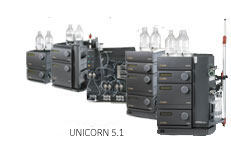

|
|

|
|
The toolbar and status bar
|

|
|
Toolbar buttons

|
The toolbar at the top
of the System Control module
contains three sets of buttons:
-
Manual Direct Commands buttons
for starting and stopping the run
-
Windows buttons
to access dialog boxes for pane selection, documentation and layout
properties
-
System Access buttons to control
the system connection.
Show and hide
The toolbars can be shown and hidden by choosing View:Toolbars and selecting the
relevant boxes.
The figure below shows the toolbar:

|
|
|
|
|
Manual Direct Commands

|
The
available Manual Direct commands buttons
in System Control are dependent
on the control status of the connection. The table below shows when each
button is available:
|
Control Status
|
Available buttons
|
|
End
|
Run
|
|
Running
|
Hold, Pause, End
|
|
Manual
|
Run, Pause, End
|
|
Hold
|
Pause, Continue, End
|
|
Method pause
|
Hold,
Continue, End
|
|
Manual pause
|
Run, Continue, End
|
|
|
|
|
|
Direct command button functions

|
The
table below describes the functions of the Manual
direct command buttons.
|
Button
|
Function
|
|
Run
|
Opens the Run dialog
box, which shows all available methods, as the first step in a method
run. If a method is loaded, Run Setup opens.
The run will start immediately if a start protocol isn't part of
the method.
|
|
Hold
|
Suspends execution of a method, but continues
Method instructions are not executed until the Continue button is pressed.
|
|
Pause
|
Behavior of the Pause button
is strategy-dependent. The Pause button
suspends execution of a method and stops all pumps so that the system comes
to a standstill.
For ÄKTAdesign systems, valves remain in the position they
were in before the pause.
Accumulated time and volume is not increased during a Pause.
Method instructions are not executed until Continue is pressed.
|
|
Continue
|
Resumes execution of a paused or held method.
|
|
End
|
Note: You can choose
to save the partial result or discard it.
|
Note: The commands
can also be found on the Manual menu.
|
|
|
|
|
Windows buttons

|
The table below describes
the functions of the Windows buttons:
|
Button
|
Function
|
|

|
Opens a dialog box where you can choose which window
panes to display. This button is equivalent to the menu command View:Panes.
|
|

|
Opens the documentation pages. Run notes can be entered
on the Notes tab and settings
can be changed. Other tabs are displayed for information only. This
button is equivalent to the menu command View:Documentation.
|
|

|
Opens the properties pages. This button is equivalent
to the menu command View:Properties.
|
|
|
|
|
|
System Access buttons

|
There are two functions
of the System Access buttons:
Disconnect/Connect system

The Disconnect button
is used to disconnect the system and leave it in a locked or unlocked
state.

The Connect button
connects the system.
Leave/Take control of the system

The Leave control button
leaves the system in a locked or unlocked state.

The Take control button
takes control of the system.
|
|
|
|
|
Status bar, connection status

|
The status bar displays a
message indicating the connection status of the window. The table
below describes the different messages:
|
Message
|
Connection status
|
|
Controlled by: <user>
|
The indicated user has a control mode connection to the
system. Other users can establish a view mode connection.
|
|
Locked by:<user>
|
The indicated user has left the system in a locked state.
Users who can supply the required password can unlock the system
and establish a connection. The password is case sensitive.
Note: It is possible
to unlock with the "lock" password or with the UNICORN logon password.
Anyone who uses the UNICORN logon password must have Unlock systems access rights.
The "lock" password is the password entered by the user who locked
the system.
|
|
System is available
|
Any user can establish a connection.
|
|
|
|
|
|
Status bar, Watch status

|
The status bar displays a
message indicating if a Watch is
active in the method.
|
|
|
|
2005-06-15
|
|
|
